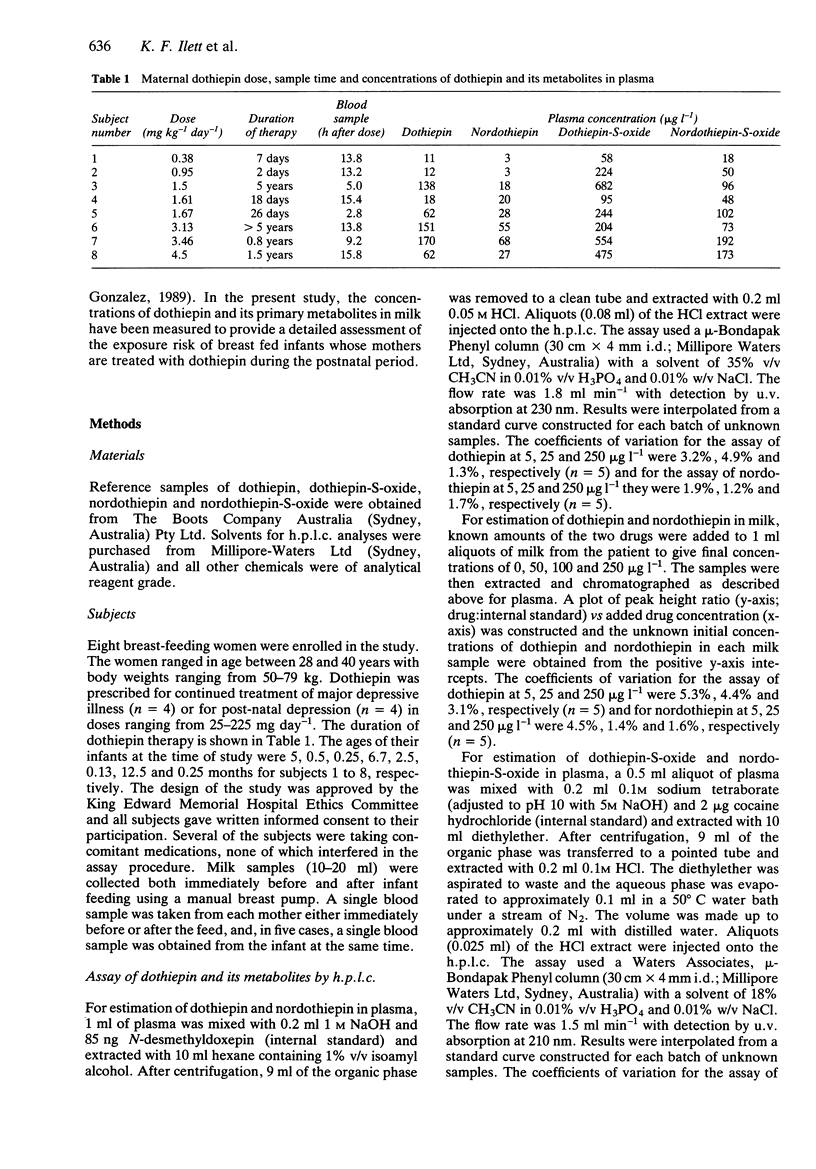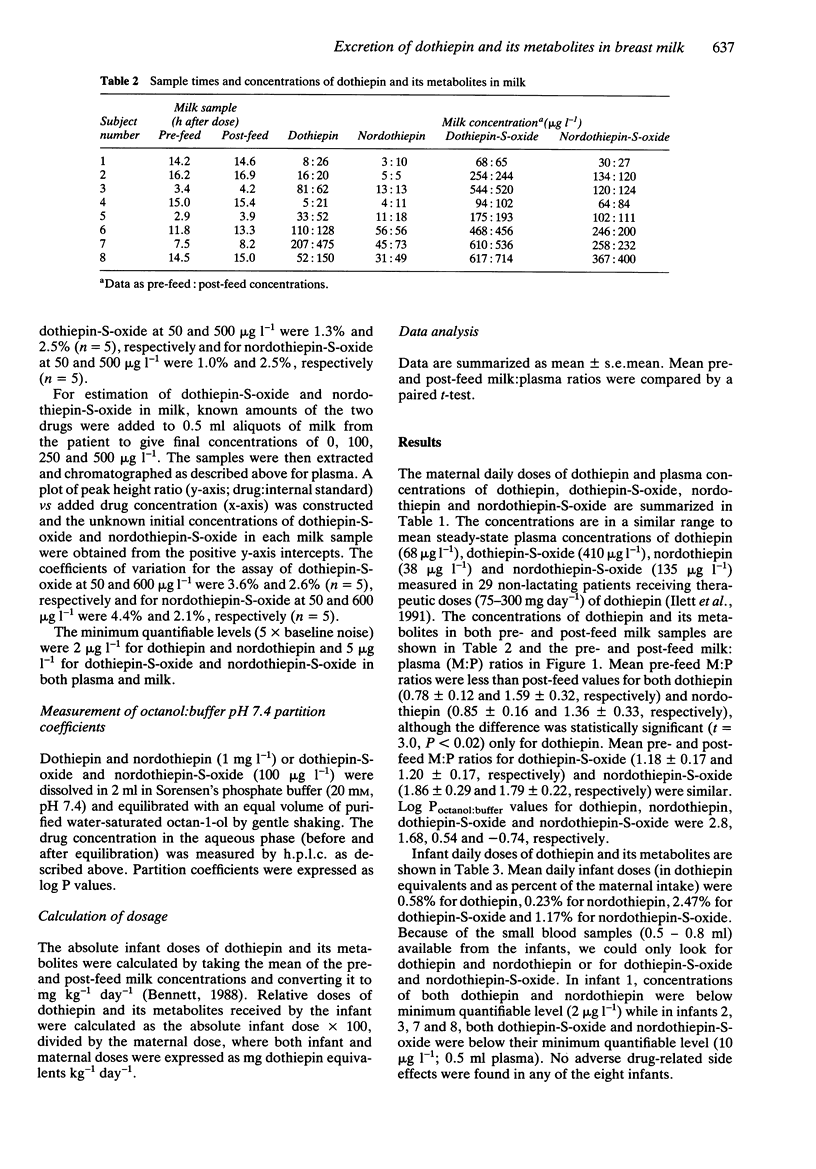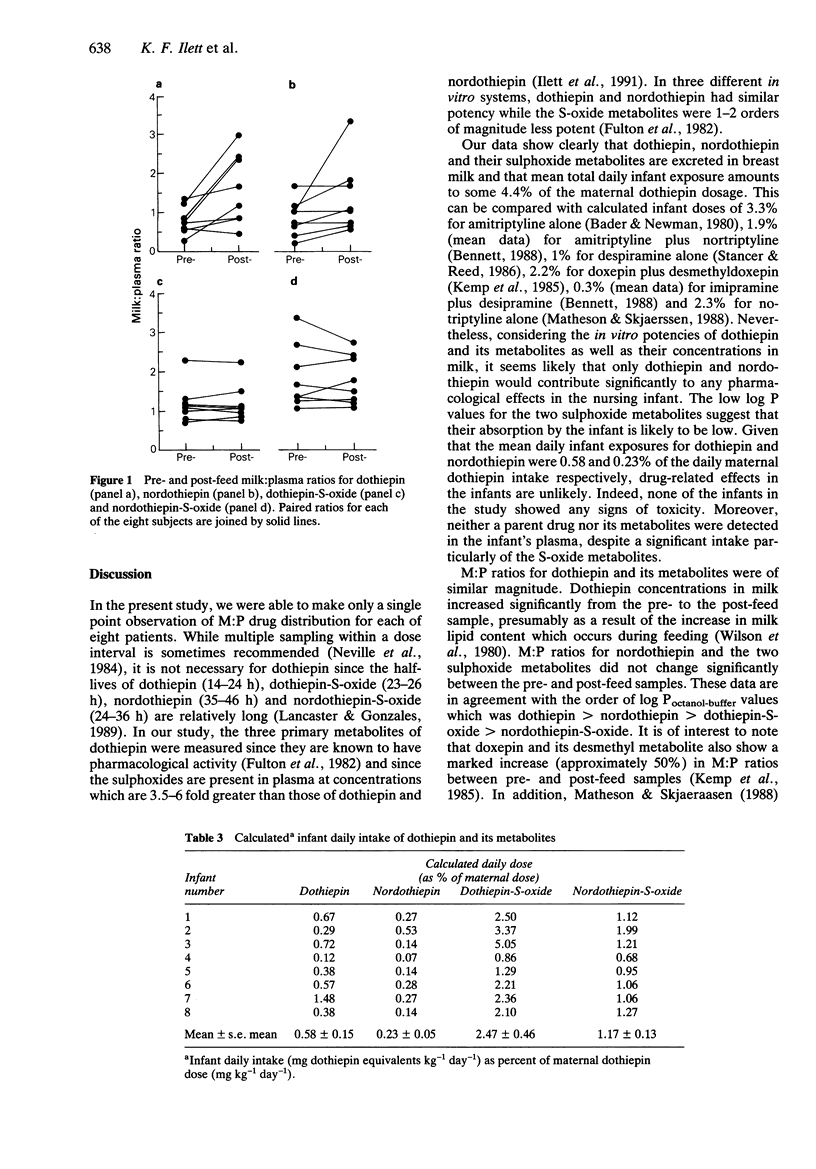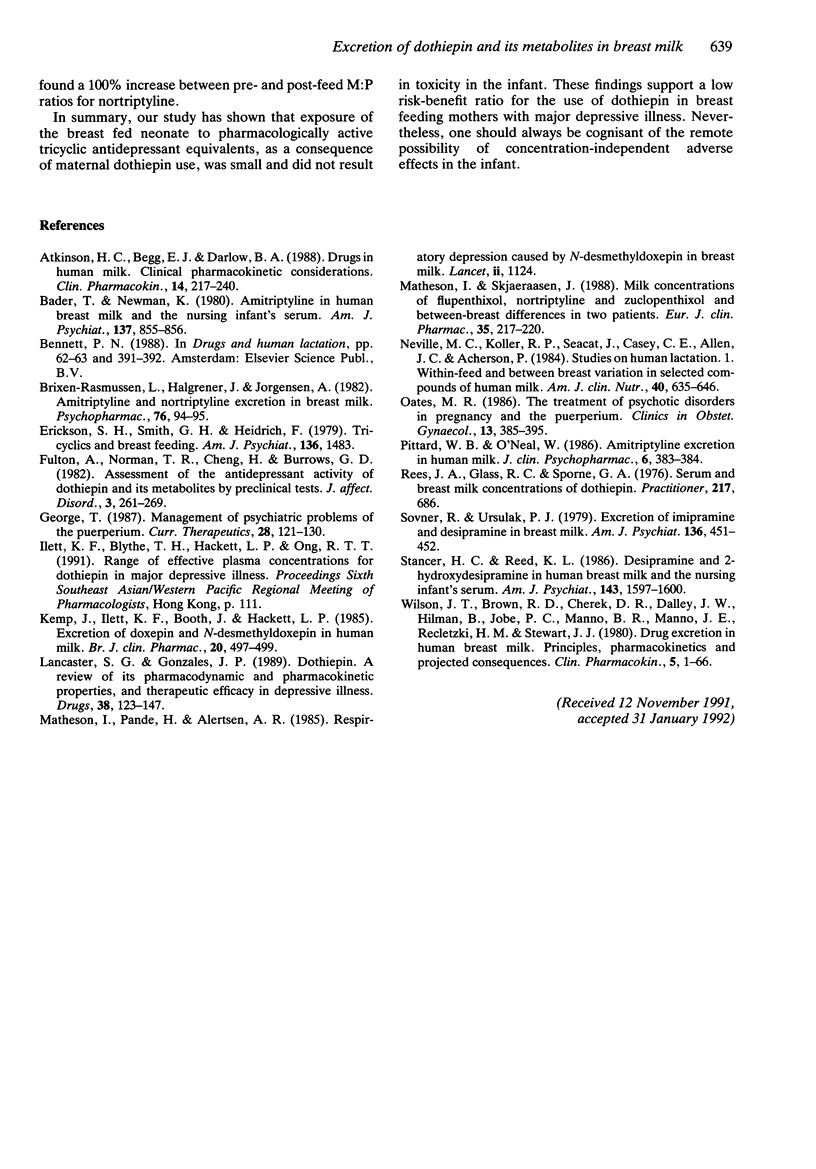Abstract
1. The excretion of dothiepin, nordothiepin, dothiepin-S-oxide and nordothiepin-S-oxide into breast milk was studied in eight women. Exposure to drug was measured in five of their infants, and possible drug-related effects were assessed in all eight infants. 2. Using pre-feed milk samples mean (+/- s.e. mean) milk:plasma (M:P) ratios were 0.78 +/- 0.12, 0.85 +/- 0.16, 1.18 +/- 0.29 and 1.86 +/- 0.29 for dothiepin, nordothiepin, dothiepin-S-oxide and nordothiepin-S-oxide, respectively. In post-feed milk samples, the mean M:P ratio for dothiepin (1.59 +/- 0.32) was significantly greater (P less than 0.05) but M:P ratios for the metabolites were similar. 3. Mean total calculated infant daily doses, (in dothiepin equivalents and as a percent of the maternal dose) were 0.58% for dothiepin, 0.23% for nordothiepin, 2.47% for dothiepin-S-oxide, and 1.17% for nordothiepin-S-oxide. 4. Plasma samples were obtained from five infants. In one, both dothiepin and nordothiepin were below their minimum quantifiable levels (2 micrograms l-1) while in four others both dothiepin-S-oxide and nordothiepin-S-oxide were below their minimum quantifiable levels (10 micrograms l-1). No adverse effects were found in any of the eight infants. 5. Use of dothiepin by depressed mothers is unlikely to be a significant hazard to their breast-feeding infants.
Full text
PDF




Selected References
These references are in PubMed. This may not be the complete list of references from this article.
- Atkinson H. C., Begg E. J., Darlow B. A. Drugs in human milk. Clinical pharmacokinetic considerations. Clin Pharmacokinet. 1988 Apr;14(4):217–240. doi: 10.2165/00003088-198814040-00003. [DOI] [PubMed] [Google Scholar]
- Bader T. F., Newman K. Amitriptyline in human breast milk and the nursing infant's serum. Am J Psychiatry. 1980 Jul;137(7):855–856. doi: 10.1176/ajp.137.7.855. [DOI] [PubMed] [Google Scholar]
- Brixen-Rasmussen L., Halgrener J., Jørgensen A. Amitriptyline and nortriptyline excretion in human breast milk. Psychopharmacology (Berl) 1982;76(1):94–95. doi: 10.1007/BF00430765. [DOI] [PubMed] [Google Scholar]
- Erickson S. H., Smith G. H., Heidrich F. Tricyclics and breast feeding. Am J Psychiatry. 1979 Nov;136(11):1483–1484. doi: 10.1176/ajp.136.11.1483. [DOI] [PubMed] [Google Scholar]
- Fulton A., Norman T. R., Cheng H., Burrows G. D. Assessment of the antidepressant activity of dothiepin and its metabolites by preclinical tests. J Affect Disord. 1982 Sep;4(3):261–269. doi: 10.1016/0165-0327(82)90010-6. [DOI] [PubMed] [Google Scholar]
- Kemp J., Ilett K. F., Booth J., Hackett L. P. Excretion of doxepin and N-desmethyldoxepin in human milk. Br J Clin Pharmacol. 1985 Nov;20(5):497–499. doi: 10.1111/j.1365-2125.1985.tb05106.x. [DOI] [PMC free article] [PubMed] [Google Scholar]
- Lancaster S. G., Gonzalez J. P. Dothiepin. A review of its pharmacodynamic and pharmacokinetic properties, and therapeutic efficacy in depressive illness. Drugs. 1989 Jul;38(1):123–147. doi: 10.2165/00003495-198938010-00005. [DOI] [PubMed] [Google Scholar]
- Matheson I., Pande H., Alertsen A. R. Respiratory depression caused by N-desmethyldoxepin in breast milk. Lancet. 1985 Nov 16;2(8464):1124–1124. doi: 10.1016/s0140-6736(85)90712-3. [DOI] [PubMed] [Google Scholar]
- Matheson I., Skjaeraasen J. Milk concentrations of flupenthixol, nortriptyline and zuclopenthixol and between-breast differences in two patients. Eur J Clin Pharmacol. 1988;35(2):217–220. doi: 10.1007/BF00609257. [DOI] [PubMed] [Google Scholar]
- Neville M. C., Keller R. P., Seacat J., Casey C. E., Allen J. C., Archer P. Studies on human lactation. I. Within-feed and between-breast variation in selected components of human milk. Am J Clin Nutr. 1984 Sep;40(3):635–646. doi: 10.1093/ajcn/40.3.635. [DOI] [PubMed] [Google Scholar]
- Oates M. R. The treatment of psychiatric disorders in pregnancy and the puerperium. Clin Obstet Gynaecol. 1986 Jun;13(2):385–395. [PubMed] [Google Scholar]
- Pittard W. B., 3rd, O'Neal W., Jr Amitriptyline excretion in human milk. J Clin Psychopharmacol. 1986 Dec;6(6):383–384. doi: 10.1097/00004714-198612000-00024. [DOI] [PubMed] [Google Scholar]
- Sovner R., Orsulak P. J. Excretion of imipramine and desipramine in human breast milk. Am J Psychiatry. 1979 Apr;136(4A):451–452. [PubMed] [Google Scholar]
- Stancer H. C., Reed K. L. Desipramine and 2-hydroxydesipramine in human breast milk and the nursing infant's serum. Am J Psychiatry. 1986 Dec;143(12):1597–1600. doi: 10.1176/ajp.143.12.1597. [DOI] [PubMed] [Google Scholar]
- Wilson J. T., Brown R. D., Cherek D. R., Dailey J. W., Hilman B., Jobe P. C., Manno B. R., Manno J. E., Redetzki H. M., Stewart J. J. Drug excretion in human breast milk: principles, pharmacokinetics and projected consequences. Clin Pharmacokinet. 1980 Jan-Feb;5(1):1–66. doi: 10.2165/00003088-198005010-00001. [DOI] [PubMed] [Google Scholar]


